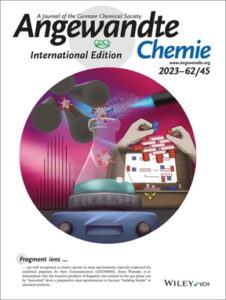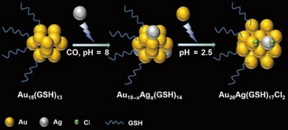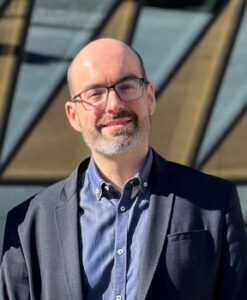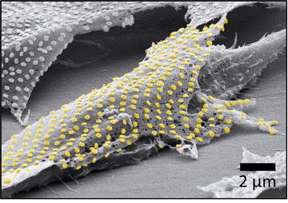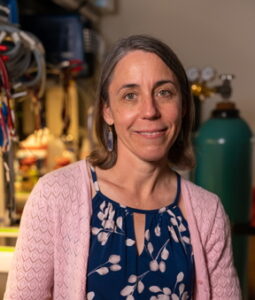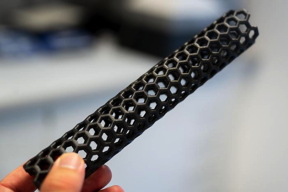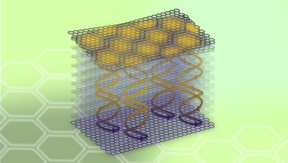Home > Press > Bridging light and electrons
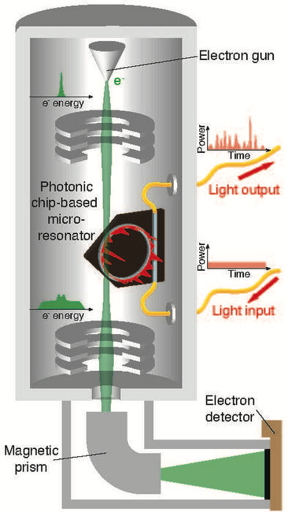 |
| Schematic of the experiment. Nonlinear spatiotemporal light patterns in a photonic chip-based microresonator modulate the spectrum of a beam of free electrons in a transmission electron microscope. CREDIT Yang et al. DOI: 10.1126/science.adk2489 |
Abstract:
When light goes through a material, it often behaves in unpredictable ways. This phenomenon is the subject of an entire field of study called “nonlinear optics”, which is now integral to technological and scientific advances from laser development and optical frequency metrology, to gravitational wave astronomy and quantum information science.
Bridging light and electrons
Lausanne, Switzerland | Posted on January 12th, 2024In addition, recent years have seen nonlinear optics applied in optical signal processing, telecommunications, sensing, spectroscopy, light detection and ranging. All these applications involve the miniaturization of devices that manipulate light in nonlinear ways onto a small chip, enabling complex light interactions chip-scale.
Now, a team of scientists at EPFL and the Max Plank Institute has brought nonlinear optical phenomena into a transmission electron microscope (TEM), a type of microscope that uses electrons for imaging instead of light. The study was led by Professor Tobias J. Kippenberg at EPFL and Professor Claus Ropers, Director of the Max Planck Institute for Multidisciplinary Sciences. It is now published in Science.
At the heart of the study are “Kerr solitons”, waves of light that hold their shape and energy as they move through a material, like a perfectly formed surf wave traveling across the ocean. This study used a particular type of Kerr solitons called “dissipative”, which are stable, localized pulses of light that last tens of femtoseconds (a quadrillionth of a second) and form spontaneously in the microresonator. Dissipative Kerr solitons can also interact with electrons, which made them crucial for this study.
The researchers formed dissipative Kerr solitons inside a photonic microresonator, a tiny chip that traps and circulates light inside a reflective cavity, creating the perfect conditions for these waves. “We generated various nonlinear spatiotemporal light patterns in the microresonator driven by a continuous-wave laser,” explains EPFL researcher Yujia Yang, who led the study. “These light patterns interacted with a beam of electrons passing by the photonic chip, and left fingerprints in the electron spectrum.”
Specifically, the approach demonstrated the coupling between free electrons and dissipative Kerr solitons, which allowed the researchers to probe soliton dynamics in the microresonator cavity and perform ultrafast modulation of electron beams.
“Our ability to generate dissipative Kerr solitons [DKS] in a TEM extends the use of microresonator-base frequency combs to unexplored territories,” says Kippenberg. “The electron-DKS interaction could enable high repetition-rate ultrafast electron microscopy and particle accelerators empowered by a small photonic chip.”
Ropers adds: “Our results show electron microscopy could be a powerful technique for probing nonlinear optical dynamics at the nanoscale. This technique is non-invasive and able to directly access the intracavity field, key to understanding nonlinear optical physics and developing nonlinear photonic devices.”
The photonic chips were fabricated in the Center of MicroNanoTechnology (CMi) and the Institute of Physics cleanroom at EPFL. The experiments were conducted at the Göttingen Ultrafast Transmission Electron Microscopy (UTEM) Lab.
Other contributors
EPFL Center for Quantum Science and Engineering
####
For more information, please click here
Contacts:
Media Contact
Nik Papageorgiou
Ecole Polytechnique Fédérale de Lausanne
Office: 41-216-932-105
Expert Contact
Tobias J. Kippenberg
EPFL
Office: +41 21 693 44 28
@EPFL_en
More on this News Release
Copyright © Ecole Polytechnique Fédérale de Lausanne
If you have a comment, please Contact us.Issuers of news releases, not 7th Wave, Inc. or Nanotechnology Now, are solely responsible for the accuracy of the content.
| Related Links |
| Related News Press |
News and information
![]() Researchers develop technique to synthesize water-soluble alloy nanoclusters January 12th, 2024
Researchers develop technique to synthesize water-soluble alloy nanoclusters January 12th, 2024
![]() Rice University launches Rice Synthetic Biology Institute to improve lives January 12th, 2024
Rice University launches Rice Synthetic Biology Institute to improve lives January 12th, 2024
![]() Development of zinc oxide nanopagoda array photoelectrode: photoelectrochemical water-splitting hydrogen production January 12th, 2024
Development of zinc oxide nanopagoda array photoelectrode: photoelectrochemical water-splitting hydrogen production January 12th, 2024
Quantum Physics
![]() 'Sudden death' of quantum fluctuations defies current theories of superconductivity: Study challenges the conventional wisdom of superconducting quantum transitions January 12th, 2024
'Sudden death' of quantum fluctuations defies current theories of superconductivity: Study challenges the conventional wisdom of superconducting quantum transitions January 12th, 2024
Possible Futures
![]() Focused ion beam technology: A single tool for a wide range of applications January 12th, 2024
Focused ion beam technology: A single tool for a wide range of applications January 12th, 2024
![]() 'Sudden death' of quantum fluctuations defies current theories of superconductivity: Study challenges the conventional wisdom of superconducting quantum transitions January 12th, 2024
'Sudden death' of quantum fluctuations defies current theories of superconductivity: Study challenges the conventional wisdom of superconducting quantum transitions January 12th, 2024
![]() Rice University launches Rice Synthetic Biology Institute to improve lives January 12th, 2024
Rice University launches Rice Synthetic Biology Institute to improve lives January 12th, 2024
Discoveries
![]() Focused ion beam technology: A single tool for a wide range of applications January 12th, 2024
Focused ion beam technology: A single tool for a wide range of applications January 12th, 2024
![]() 'Sudden death' of quantum fluctuations defies current theories of superconductivity: Study challenges the conventional wisdom of superconducting quantum transitions January 12th, 2024
'Sudden death' of quantum fluctuations defies current theories of superconductivity: Study challenges the conventional wisdom of superconducting quantum transitions January 12th, 2024
Announcements
![]() Researchers develop technique to synthesize water-soluble alloy nanoclusters January 12th, 2024
Researchers develop technique to synthesize water-soluble alloy nanoclusters January 12th, 2024
![]() Scientists use heat to create transformations between skyrmions and antiskyrmions January 12th, 2024
Scientists use heat to create transformations between skyrmions and antiskyrmions January 12th, 2024
![]() Development of zinc oxide nanopagoda array photoelectrode: photoelectrochemical water-splitting hydrogen production January 12th, 2024
Development of zinc oxide nanopagoda array photoelectrode: photoelectrochemical water-splitting hydrogen production January 12th, 2024
Interviews/Book Reviews/Essays/Reports/Podcasts/Journals/White papers/Posters
![]() Focused ion beam technology: A single tool for a wide range of applications January 12th, 2024
Focused ion beam technology: A single tool for a wide range of applications January 12th, 2024
![]() 'Sudden death' of quantum fluctuations defies current theories of superconductivity: Study challenges the conventional wisdom of superconducting quantum transitions January 12th, 2024
'Sudden death' of quantum fluctuations defies current theories of superconductivity: Study challenges the conventional wisdom of superconducting quantum transitions January 12th, 2024
Aerospace/Space
![]() Manufacturing advances bring material back in vogue January 20th, 2023
Manufacturing advances bring material back in vogue January 20th, 2023
![]() The National Space Society Congratulates NASA on the Success of Artemis I Same-day Launch of the Hakuto-R Lunar Landing Mission will Help Support Future Lunar Crews December 12th, 2022
The National Space Society Congratulates NASA on the Success of Artemis I Same-day Launch of the Hakuto-R Lunar Landing Mission will Help Support Future Lunar Crews December 12th, 2022
Photonics/Optics/Lasers
![]() Development of zinc oxide nanopagoda array photoelectrode: photoelectrochemical water-splitting hydrogen production January 12th, 2024
Development of zinc oxide nanopagoda array photoelectrode: photoelectrochemical water-splitting hydrogen production January 12th, 2024
![]() Thermal impact of 3D stacking photonic and electronic chips: Researchers investigate how the thermal penalty of 3D integration can be minimized December 8th, 2023
Thermal impact of 3D stacking photonic and electronic chips: Researchers investigate how the thermal penalty of 3D integration can be minimized December 8th, 2023
![]() Night-time radiative warming using the atmosphere November 17th, 2023
Night-time radiative warming using the atmosphere November 17th, 2023
Quantum nanoscience
![]() 'Sudden death' of quantum fluctuations defies current theories of superconductivity: Study challenges the conventional wisdom of superconducting quantum transitions January 12th, 2024
'Sudden death' of quantum fluctuations defies current theories of superconductivity: Study challenges the conventional wisdom of superconducting quantum transitions January 12th, 2024
![]() What a “2D” quantum superfluid feels like to the touch November 3rd, 2023
What a “2D” quantum superfluid feels like to the touch November 3rd, 2023
![]() A new qubit platform is created atom by atom October 6th, 2023
A new qubit platform is created atom by atom October 6th, 2023
- SEO Powered Content & PR Distribution. Get Amplified Today.
- PlatoData.Network Vertical Generative Ai. Empower Yourself. Access Here.
- PlatoAiStream. Web3 Intelligence. Knowledge Amplified. Access Here.
- PlatoESG. Carbon, CleanTech, Energy, Environment, Solar, Waste Management. Access Here.
- PlatoHealth. Biotech and Clinical Trials Intelligence. Access Here.
- Source: http://www.nanotech-now.com/news.cgi?story_id=57442
- :has
- :is
- :not
- $UP
- 000
- 10
- 12th
- 17th
- 18th
- 20th
- 27
- 3d
- 3rd
- 6th
- 7th
- 8th
- a
- ability
- Able
- accelerators
- access
- accuracy
- acoustic
- across
- addition
- Adds
- advances
- AL
- All
- allowed
- Alloy
- also
- an
- and
- applications
- applied
- approach
- ARE
- around
- Array
- Artemis
- AS
- astronomy
- At
- atom
- awarded
- away
- back
- BE
- Beam
- between
- biology
- bridging
- bring
- brought
- by
- called
- CAN
- carbon
- Center
- CGI
- challenges
- chemistry
- chip
- Chips
- Claus
- click
- co2
- cold
- COM
- comment
- commitment
- compatible
- complex
- computing
- Condensed matter
- conditions
- conducted
- content
- conventional
- Conversion
- could
- create
- created
- Creating
- credit
- crucial
- Current
- de
- Death
- December
- del
- demonstrated
- Detection
- develop
- developing
- Development
- Devices
- different
- direct
- directly
- Director
- driven
- dynamics
- E&T
- Electronic
- electrons
- Emissions
- empowered
- enable
- enabling
- end
- energy
- Entire
- Ether (ETH)
- experiment
- experiments
- Explains
- extends
- feels
- field
- films
- First
- first time
- fluctuations
- For
- forcing
- form
- formed
- Foundation
- Free
- Frequency
- from
- fundamental
- future
- futuristic
- GAS
- generate
- generated
- gif
- Goes
- Graphene
- gravitational
- greenhouse gas
- Harvesting
- Have
- Heart
- help
- helped
- High
- hold
- How
- http
- HTTPS
- hydrogen
- i
- if
- Imaging
- Impact
- improve
- in
- Inc.
- individual
- information
- inside
- instead
- Institute
- integral
- integration
- interact
- interaction
- interactions
- International
- international space station
- into
- investigate
- involve
- IT
- January
- jpg
- Key
- lab
- landing
- laser
- Last
- launch
- launches
- lead
- Led
- left
- lenses
- light
- like
- links
- Lunar
- made
- material
- Matrix
- Matter
- max
- Metrology
- Microscope
- Microscopy
- Mission
- more
- move
- multidisciplinary
- nanotechnology
- Nasa
- National
- Nature
- net
- New
- news
- nicholas
- Noble
- novel
- November
- now
- ocean
- october
- of
- offset
- often
- on
- opened
- opportunities
- Optical physics
- optics
- Optimize
- or
- Other
- particle
- particular
- Passing
- patterns
- Paul
- perfect
- perfectly
- perform
- phenomenon
- PHP
- Physics
- platform
- plato
- Plato Data Intelligence
- PlatoData
- please
- possibilities
- Post
- posted
- potent
- power
- powerful
- press
- Press Release
- princeton
- probe
- processing
- Professor
- published
- Quantum
- quantum computing
- quantum information
- quantum technology
- Qubit
- range
- ranging
- recent
- release
- Releases
- researcher
- researchers
- Resistance
- responsible
- Results
- return
- Rice
- robust
- Room
- s
- Save
- says
- Science
- SCIENCES
- scientific
- scientists
- Search
- Second
- seen
- sensor
- setup
- Shape
- Share
- show
- Signal
- single
- SIX
- small
- Society
- solely
- solid
- Space
- space station
- Spectroscopy
- Spectrum
- speed
- stable
- stacking
- start
- station
- structures
- Study
- subject
- submit
- success
- sudden
- Superconductivity
- support
- surf
- switzerland
- synthesize
- synthetic
- Systems
- Tandem
- team
- technique
- technological
- Technology
- telecommunications
- tens
- territories
- test
- Testing
- that
- The
- the world
- their
- Them
- thermal
- These
- they
- this
- Through
- time
- to
- tool
- tools
- transformations
- traps
- Traveling
- tunnel
- type
- understanding
- university
- unpredictable
- us
- use
- used
- uses
- using
- various
- was
- Wave
- waves
- ways
- were
- which
- WHO
- wide
- Wide range
- will
- wind
- wisdom
- with
- Work
- world
- Yahoo
- years
- you
- zephyrnet











